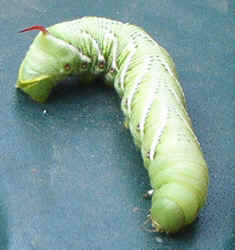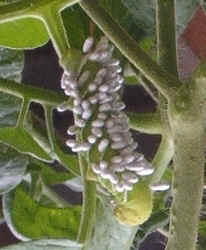 |
||
 |
Tobacco Hornworm
Carolina Sphinx Moth
Scientific Name: Manduca sexta
Family Name: Sphingidae
 |
||
 |
Wingspan 3-1/2 - 4-1/2". Wings blackish gray, mottled and striped with brown and white. Abdomen has a row of 6 orange-yellow spots on each side. Caterpillar, to 3-3/4", in green with diagonal white stripes and red horn at rear. Habitat: Wild or cultivated fields whee herbaeceous plants of the nightshade family are numerous. Range: Southern New England to Minnesota, south to the Golf, southwest to Arizona; most common in the South. Food: Caterpillar eats foliate of plants in the nightshade family, such as potato, tomato, and tobacco. Flight: July-October. Information: This moth is also known as the "Carolina Sphinx" and "Six-spotted Sphinx." In southern tobacco-growing states the adult is called a "tobacco fly." Its caterpillars hatch from large green eggs and grow rapidly in 40-5 weeks. The pupae have a distinctive juglike handle. [Milne, Lorus and Margery, National Audubon Society Field Guide to North American Insects and Spiders, Alfred A. Knopf, New York, 1980]
The Tobacco Hornworm is an economically significant pest because of its voracious appetite for tobacco, tomato, potato, and other related crops. An abundant food supply will nourish the larva to maturity at a startling 6 inches in length. It is green or sometimes green-black with 7 whitish diagonal lines above the spiracles along each side. The rear horn is red. It is the larva of teh Carolina Sphinx Moth. The Tomato Hornworm, larva of the Five-spotted Hawk Moth, is very similar, but its rear horn is green and blac, and its diagonal stripes form an angle around the spiracles instead of the straight lines of the Tobacco Hornworm. It feeds on the same plants. Both larvae are often victims of parasitic wasps; the wasps' white cocoons may protrude from the host caterpillar's body. With wings 4 1/2 inches across, the adult moths look alike, with yellow-orange spots along the sides of their abdomens. They are common in most of the United States. The overwintering pupa has a tongue case, or "jug handle," near the head. [Wright, Amy Bartlett, Peterson First Guides Caterpillars, Houghton Mifflin Company, Boston/NewYork, 1993]
Butterfly and Moth Home Page * Butterfly and Moth Books * Nature Lovers